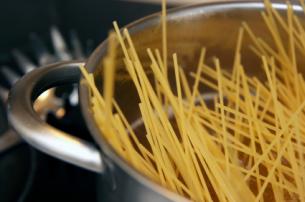
How to Cook Pasta 101
My grandparents, Domenico De Domenico and Maria Ferrigno De Domenico, started Golden Grain Macaroni Co. back in the early 1900’s. It was her idea as her family had a pasta factory in Italy and she wanted to bring them over and start a pasta company in San Francisco. I grew up watching my parents cook pasta so I thought everyone knew how to do it as it seemed so simple. But over the years I’ve noticed that a lot of people don’t know how to properly cook pasta so this is for all of you out there who would like to know the simplest way to cook pasta so that it comes out right every time.
My aunt Katherine Reichert De Domenico wrote a cookbook many years ago called “Pasta with a Flair” and in it she details the proper way. I don’t think I can say it any better…
First of all you need a lot of water – 12-16 ounces of pasta requires at least 5 quarts of water. The difficulty usually results from trying to cook pasta in a pot that is too small or not using enough water. The smallest pot you should use is a 6-quart saucepot. The pasta must float free in the water in order to cook properly.
Once the water is brought to a rolling boil, salt is added. Since many people today are on salt-free diets, salt is an optional ingredient. Now I will add that it does produce a better tasting product to use salt. I put in about a tablespoon just before adding the pasta. Many people put it in when they fill the pot with water and turn on the heat – but that just dissipates the taste of the salt so that’s why it’s best to add it just before putting in the pasta.
Slowly add your pasta to the boiling water and stir gently until the water returns to a boil. I cover the saucepot temporarily with a lid to let it return to a boil more quickly. When it’s boiling again I remove the lid and leave it off for the rest of the cooking time. As my Aunt says “pasta products should be cooked to the firm but tender stage, which is called al dente or “firm to the tooth”.
I often use the Barilla brand of pasta and their cooking times are pretty accurate but I do start checking the pasta about a minute ahead of the cooking time they have on the package. I pull out a piece of macaroni or a strand of long goods (that was what we called spaghetti etc.) and cut it in half to see if there’s a white chalky looking area in the middle. If it’s there the pasta is not done – at that point I start checking it every 30 seconds. When the white chalkiness is gone it means the pasta is cooked throughout and is ready to come out of the pot. NOW. Pasta waits for no man or woman.
Make sure you have a colander in the sink ready to go. Here’s a Tip to make sure your pasta stays nice and hot – put a large pasta bowl underneath the colander to trap the water – then lift out the colander and shake it once or twice, (not bone dry leave a little moisture) but don’t EVER rinse the pasta (unless you’re making cold pasta salad). Then drain the bowl with the hot water in it and pour your pasta into the bowl. Right away add some sauce to the bowl and toss it to coat the pasta.
Some people like to drain the pasta and add it to the sauce in the saucepan where they toss it and let it blend there for a minute or two. I don’t often do that as my saucepan is usually too full of sauce or I may not need all the sauce for the amount of pasta I’m cooking so I usually prefer to keep them separate. I also put the individual pasta bowls I’m using in the sink and pour boiling water in them also to heat them. Then I drain the bowls, add the pasta, which already has some sauce on it and add a bit more sauce on top. I like it covered but not smothered in sauce. Too much sauce is not a good thing. At that point if the recipe calls for grated cheese you add it freshly grated right then before you serve it. Now Mangia and enjoy before the pasta gets cold!

